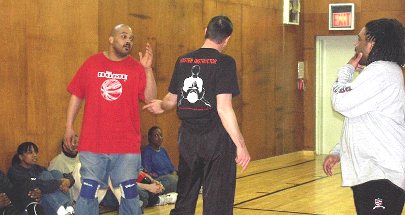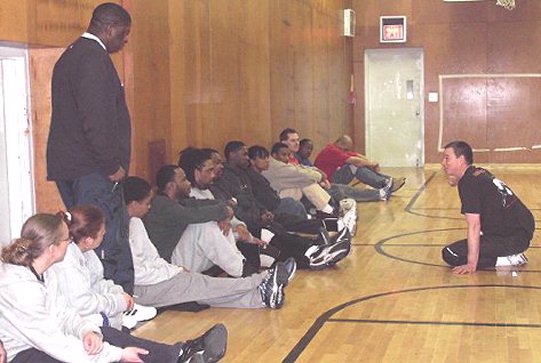
Re-certification of "Handle With Care" trainers at
the RTF--2/13/02

Re-certification of "Handle With Care" trainers at
the RTF--2/13/02
The Aichhorn RTF is intended to provide a safe, secure, pleasant home for 32 adolescents whose behavioral disturbances have made it impossible to maintain them anywhere else. It has been successful in this respect since it opened in 1991. No application for admission which New York State's Pre-Admission Certification Committee has forwarded to us has been refused because a youngster was too difficult to handle, and no admitted resident has been transferred or discharged because of management problems. Our residents are generally physically large boys and girls between 13 and 19 who are transferred from other mental health, juvenile justice or foster care residential facilities because they have been too aggressive and/or self-destructive to maintain outside hospitals or correctional institutions. The six-floor RTF building is not shielded by a "campus" but opens directly onto the sidewalks of a mixed-income residential New York City neighborhood of similar-sized brownstone apartment houses, with direct access to subway and bus transportation.
Serious injuries to residents or staff are exceedingly rare (fewer than one per year), and there has never been a "Class A" incident as defined by New York State (homicide, suicide), rape, or a major injury to residents or staff from an assault. [Additionally, the rate of elopement is very low--three cases in 2000-2001, all from off-site trips or therapeutic leave, with one of the three re-admitted a few weeks later.]
Other agencies have been less fortunate. The picturesque "cottages" of their suburban campuses have witnessed a number of very serious assaults (including homicide and rape among residents on one campus, and, in recent weeks, the reported torture and attempted murder of a staff member at another). This is particularly ironic because the agencies involved, which have hundreds of beds allegedly offering a "spectrum" of care, have repeatedly transferred their most difficult children to our Aichhorn RTF because the youngsters were too old, too violent, or simply "don't fit into our program."
We have never used a "seclusion" or "time-out" room, or a camisole or other mechanical restraint device to maintain order, and our use of psychotropic medication is quite moderate. There are no metal detectors or panic buttons, and the only surveillance cameras are used to monitor the outside doors during hours when there is no receptionist.
How then, do we maintain safety? The underlying answer is that the program is structured to emphasize a culture of civility, and an atmosphere that is truly "secure"--not in the sense that the word has taken on as a euphemism for barbed wire, correctional hardware, and armed guards, but in the sense that a well cared-for child is said to feel secure. Most residents--even the angriest--do not want to hurt most of the staff most of the time, and most have at least some recognition that they are pretty well off where they are. The size of our RTF program, which contains four 8-bed apartments as well as educational and clinical program space, allows adequate staffing to address virtually any emergency. If these components were scattered around a campus, or located separately in an urban area, the individual units would inevitably have only one or two adults present at many hours--potentially a very dangerous situation. Providing that the tone of the program assures that violent outbursts will arise from isolated individuals, not from large organized groups of residents who seriously hate everyone around them, a moderately sized facility (roughly 25 to 50 beds) can safely manage almost any teenagers, keeping most of them fairly happy most of the time, and exerting direct control in the relatively unusual situation where it becomes necessary. (The advantages of moderate size probably begin to disappear when the population rises very much higher because individual attention decreases and standard management rules make for a less flexible, more "institutional" environment in which considerable group resentment can easily be generated before it is recognized and defused.)
For many of our residents, a safe, benevolent environment is a novel experience, and it often takes some time after they join us for them to become less angry and depressed. But experience has shown that we can usually reach these children by making clear that we will not abandon them (or send them away), we will protect them (from themselves as well as others), and that we will not bully them--in short, that we have control, but will not abuse it.
Training new direct care staff in this area can be complicated, but the basic message is simple: always convey confidence that we (the staff as a group) have ultimate control, but that this is a way of trying to keep everyone safe and happy, not a license to make arbitrary decisions or bully people.
The program is designed to assure that these statements are true. The building itself is designed and maintained to contain virtually any behavior, although this does not require any intrusive hardware. Every new child care worker spends five days "shadowing" a mentor, one of the experienced child care staff, as well as a day receiving hands-on training in crisis intervention techniques including physical restraint, before being assigned any work. Every direct care staff member (including nurses, teachers, social workers, and other senior supervisors) participates in refresher training in crisis intervention and in techniques of safe physical restraint on a quarterly basis. Our in-house trainers, who are volunteers from among the senior child care and education staff, are certfiied (and annually re-certified) in the "Handle With Care" intervention techniques.

Bruce Chapman of Handle
With Care® leading the trainers' re-certification session.
Telephones are always available, and in any difficult situation, workers can request "all available staff". In contrast to a picturesque but isolated "cottage," in our building numerous staff, including professionals and other experienced supervisors, can always be on hand at short notice to calm a disturbance, often without direct physical confrontation. Should a physical restraint occur, staff have considerable training and experience in working together to gain control of a resident (NOT engage in a fight). Such techniques as passing off responsibility so that an individual staff member who may be the direct object of an attack is quickly replaced by a more neutral (or even a particularly well-liked) staff member, moving uninvolved residents away from the area of the disorder, persuading youngsters to accept oral medication, and trying to encourage verbal rather than physical expression of feelings, are all emphasized repeatedly in staff training. Our emphasis on encouraging questions and discussion of any disagreements within the program extends through all levels of staff as well as to residents. It is specifically intended to foster reasonable verbal rather than irrational physical confrontations.
Since the opening of the RTF, every instance of physical restraint (and every other unusual event) has been documented by the workers involved before the end of their shift, in our computerized clinical record, along with a statement about whether the patient has made any complaint of abuse related to the event. This documentation is routinely reviewed by the unit leader, the patient's therapist, and other senior staff. If there is any complaint of abuse, the patient is examined immediately by the facilty nurse, any injuries are documented and photographed, and the matter is referred to the facility Incident Investigator who interviews all concerned and presents the results for discussion by the Aichhorn Executive Committee, which includes all of the senior staff. Even if there is no complaint, workers involved in a physical restraint are expected to meet with the Site Supervisor on duty before the end of the shift to discuss whether any believe that handling of the matter could have been improved.
The number of restraints, and their location and timing, which residents and staff are involved, the use of oral or intra-muscular medication, the occurrence and nature of injuries during restraint, etc., are all monitored on a monthly basis by the Quality Assurance Coordinator who presents this data, and any trends it suggests, to the Executive Committee for discussion. Administrative issues such as staffing imbalances, questionable policies, or specific personnel problems, as well as particularly difficult clinical management issues, can be promptly addressed by senior staff representing all areas of the operation.
In short, the entire staff takes maintaining a safe, secure environment as everyone's very serious responsibility, and demonstrates this concern on an on-going basis. And that seems to be all that is needed.